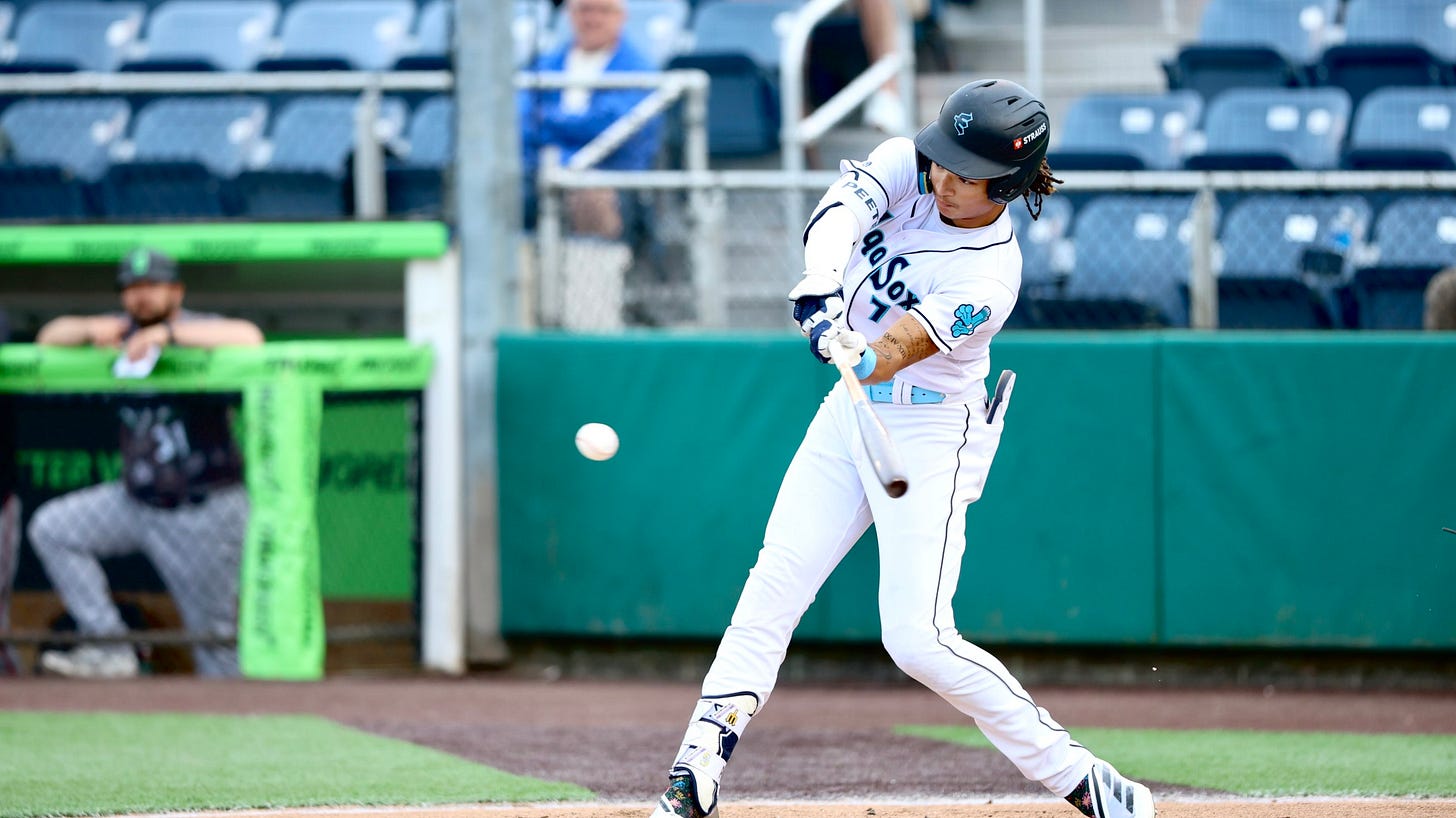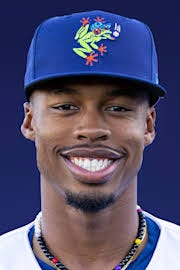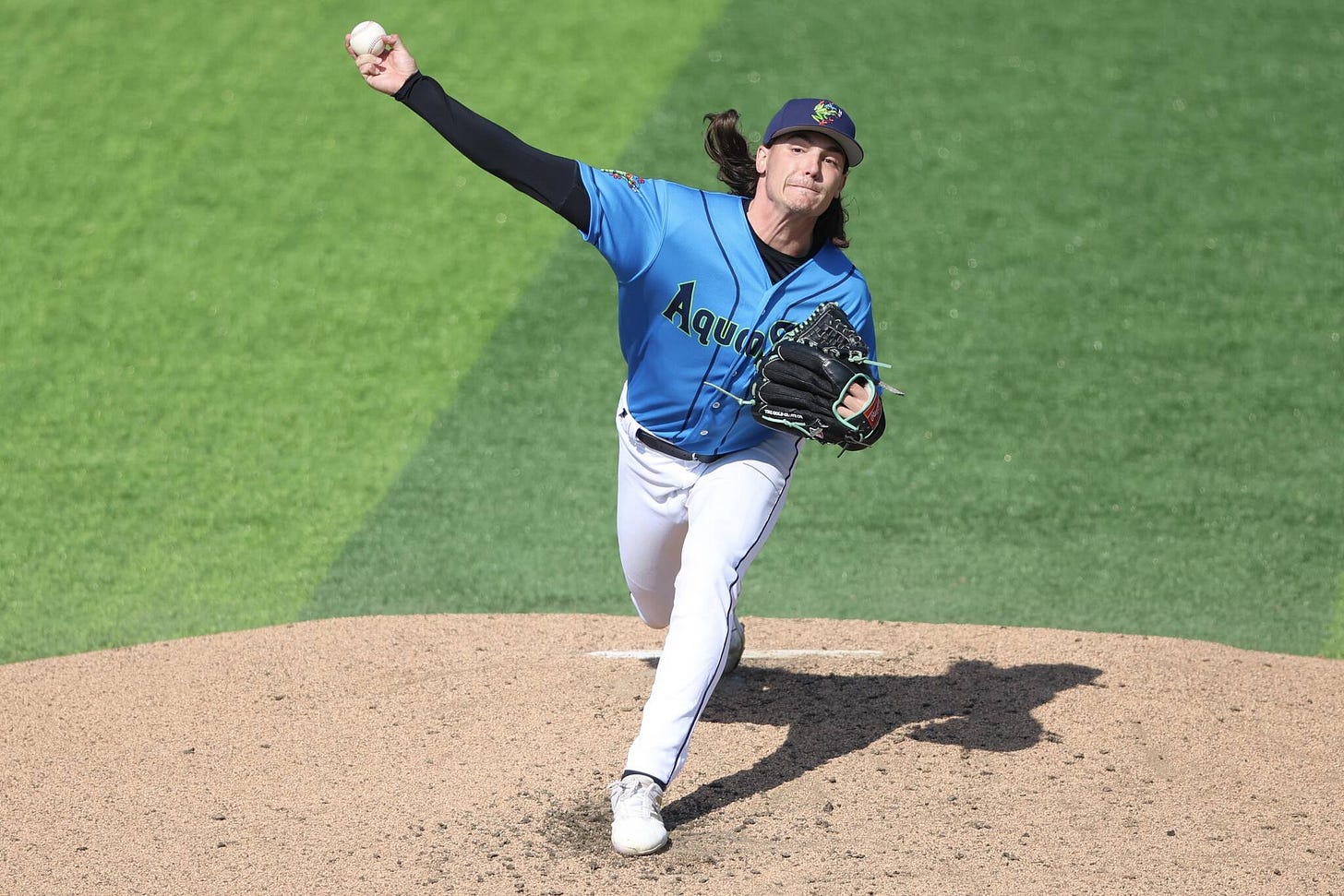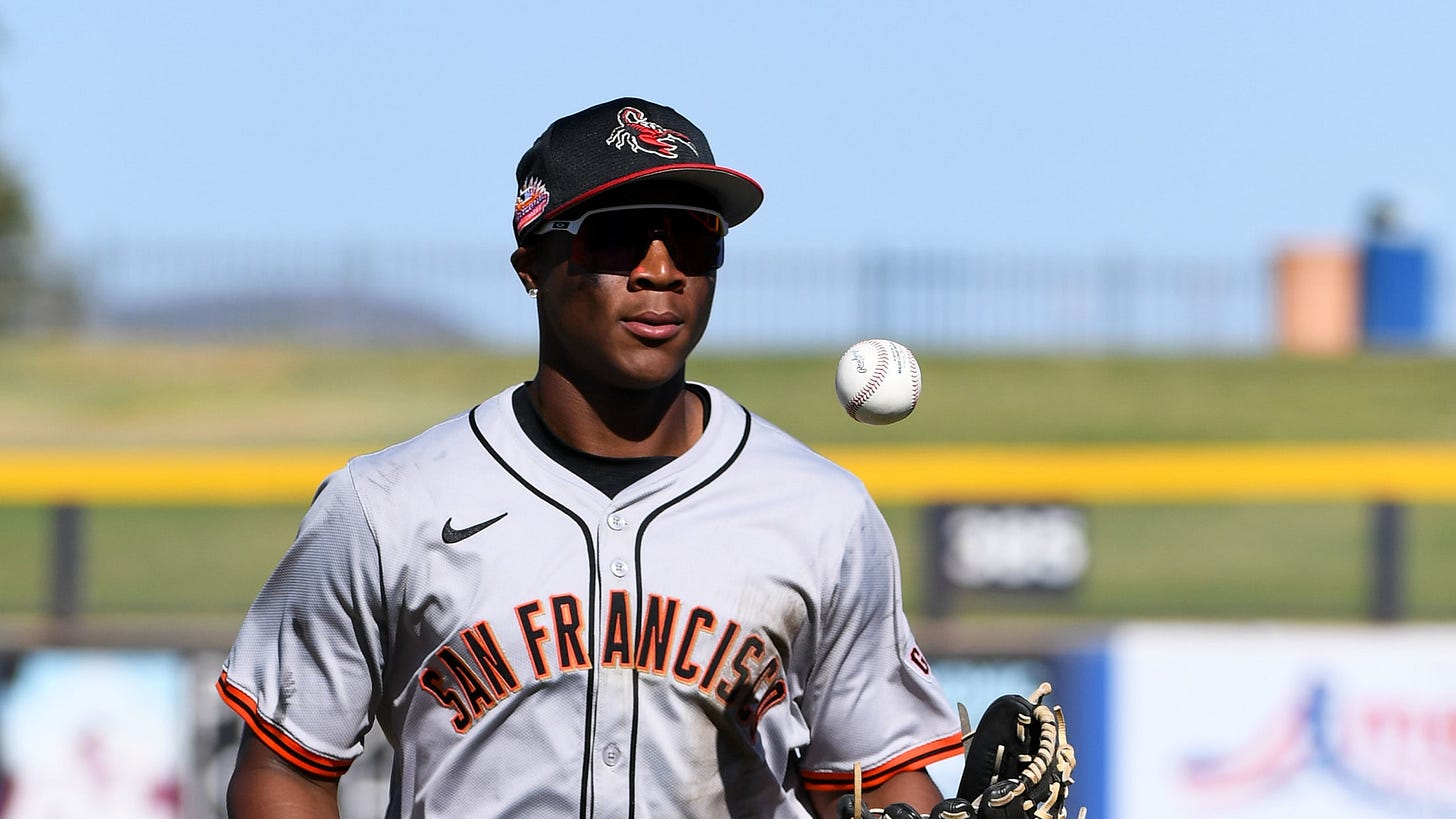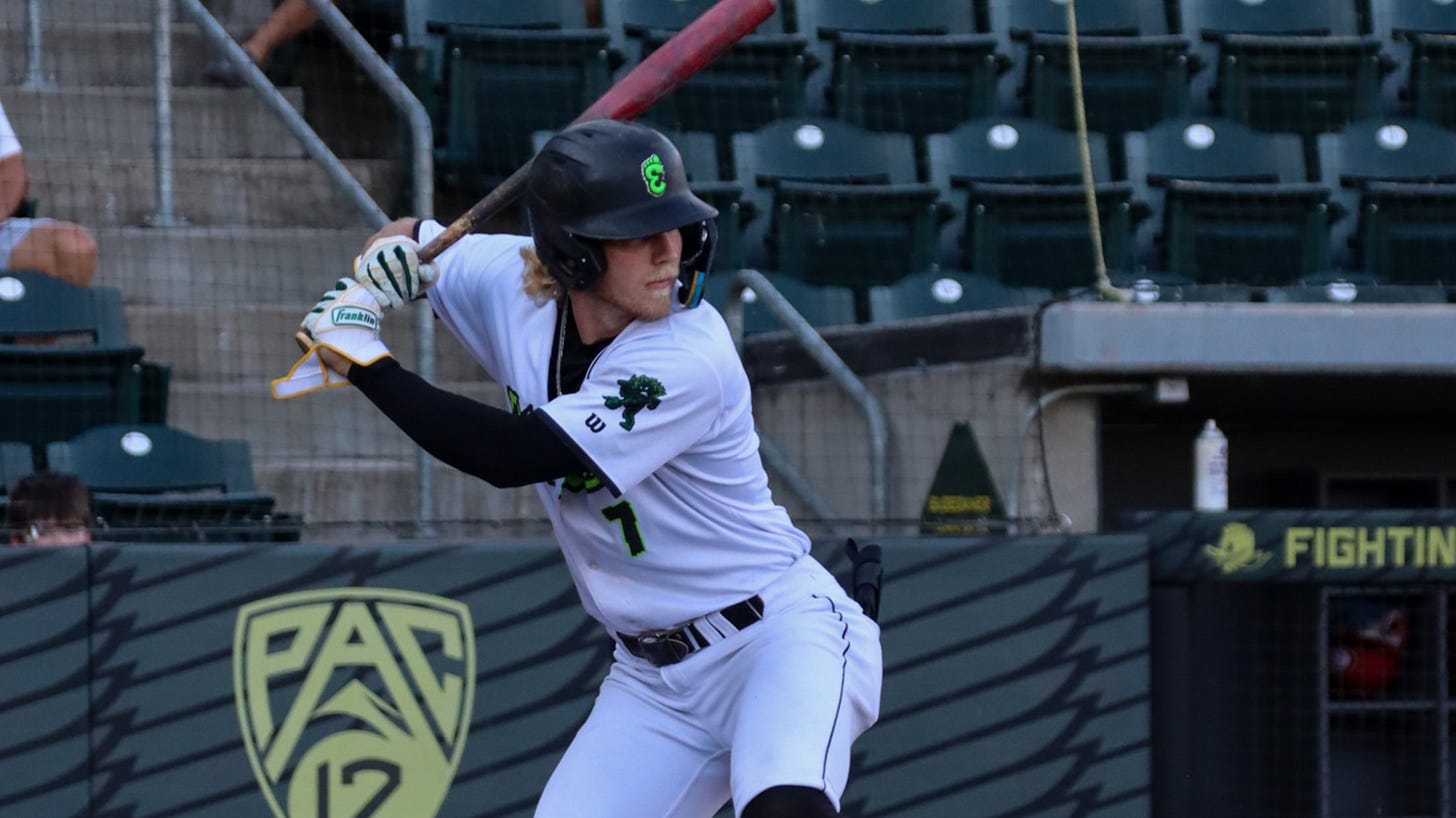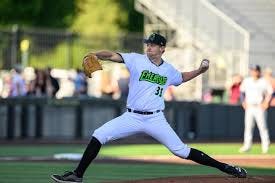Scouting Notes and Grades from 6/29/2025
Scouting notes and grades for select players during last Sunday's matchup between the Giants and Mariners High-A affiliates.
We’re taking a break from my Top 75 draft prospects series (which will wrap up this Friday with players 51-75 on my board) to focus on some players of note from the last game I had the pleasure of scouting. On the 29th of June, I had the opportunity to watch the Everett Aquasox and Eugene Emeralds go head-to-head at Funko Field. After recent promotions in the Seattle system, these two teams were much closer in terms of future MLB talent, and here I’ll spotlight a few players on both teams that I feel are most likely to impact a major league club in the future. I try not to write about a player more than once, so as a result, Luis Suisbel will not appear here, even though I am incredibly high on him (he had another great game at third base, for what it’s worth). If you would like to read my thoughts on Suisbel, as well as some other minor leaguers I have already covered, click here. As a reminder, all grades are on the 20-80 scale, and PD/PR stands for plate discipline/pitch recognition and serves as a grade of a player’s approach at the plate.
Aquasox Players
Colt Emerson SS L/R (19)
Hit: 60 | PD/PR: 50 | In-game Power: 45 | Raw Power: 55 | Run: 55 | Arm: 55 | Field: 50 | OVR: 55
Emerson is a very well-rounded player who has quite a bit of upside if he can ever learn to fully tap into his above average raw power. His swing is super smooth, and his barrel control is exceptional. He seemingly always gets the fat part of the bat to the ball. However, with his current approach, this ability is actually hurting him. Because he is so good at getting the barrel to the baseball, if he swings at a pitch, it is almost guaranteed to be put in play. As it is, he often swings early in counts and doesn’t see enough pitches to get to one he can do damage with. The plus contact ability combined with the current approach often results in less-than-ideal contact, which is part of the reason why his in-game power is fringe-average and well below his power potential. If he can learn to be more patient in the box and wait for a pitch he can do damage with, I expect his performance to tick up across the board, especially the power. Again, Emerson does not chase excessively (he is quite good at recognizing o-zone spin and offspeed stuff and laying off). His problem is swinging at the wrong strikes, in other words, ones that he can’t do damage with. Once he improves here, I do believe his ceiling (perennial All-Star) will become more accessible to him. Currently, I have him as an above average regular (3-4 WAR player with the occasional All-Star caliber year) with 12-15 homers a season (if he starts recognizing which pitches he can pull in the air, he has 20+ homer power in the tank).
Emerson is an above average runner presently, though I expect him to slow to average speed once he fully fills out his frame. On defense, I think he’ll stick at shortstop at least through the prime of his career. His actions and hands are good, and he has plenty of arm strength to make throws from deep in the hole. While I can understand concerns over his range if he slows down any, I don’t see a reason to worry about this just yet. He has a quick first step and generally displays above average range. Realistically in the long-term, this probably slides closer to average, but this is still plenty good enough to stay at short so long as he doesn’t run into a vastly superior defender at the position (I don’t see one right now in the Seattle system).
Tai Peete OF L/R (19)
Hit: 40 | PD/PR: 40 | In-game Power: 50 | Raw Power: 60 | Run: 65 | Arm: 65 | Field: 55 | OVR: 45
Peete has made some notable strides defensively in center. His routes have gotten much better, which has allowed him to use his easily plus speed to his advantage, tracking down well-hit balls in the gaps. He has a cannon for an arm, and he made an impressive throw to nab a baserunner going 1st to 3rd on a single to fairly deep left-center. I can comfortably say he is an above average centerfielder with the chance for plus if he can continue to improve his routes and mechanics (there is no reason he won’t be able to do so). His 65 grade speed makes him a fantastic base runner and a stolen base threat, giving him two areas that prop up the profile and give him a useable floor.
Unfortunately, Peete still hasn’t taken a step forward offensively. He is still swinging at almost everything that isn’t a “waste” pitch and not making contact on very much of it (he is currently running a 32.3% K rate in High-A with a .275 OBP). Needless to say, his current approach is not working, and it will not translate to a higher level of the minors, let alone the big leagues. His leg kick is considerably smaller than it was last year, though I think he will need to eventually adopt a true toe-tap to make enough contact to get to his plus raw power. He is still planting his lead foot inconsistently, which is throwing off his timing in the box (again, this is why I think a toe-tap would be beneficial for him). If he can adopt either a more patient approach or improve his contact ability, then there is huge upside here because of the plus raw pop, speed, and defense. However, there is high risk and variance in the profile simply because he presently will not hit enough to garner consistent playing time at the major league level.
Curtis Washington Jr. OF R/R (25)
Hit: 45 | PD/PR: 45 | In-game Power: 40 | Raw Power: 40 | Run: 65 | Arm: 50 | Field: 55 | OVR: 40
Like Peete, Washington Jr.’s profile is carried by his speed and defense. He is nearly a double plus runner who makes good reads and has sound outfield mechanics (this should be expected of a player with his raw tools, age, and experience on the grass). He is a smart baserunner, which gives him a huge advantage here when combined with his 65 grade speed.
While he is certainly a better hitter and has a better approach than Peete, he is also six years older, which is a knock against him. There are a lot of moving parts in his swing, which doesn’t necessarily hurt his hit tool, so much as it leads to plenty of groundballs and weak fly balls. He has a small frame, and I don’t think he develops anything beyond below average power. Once again, this comes down to being able to hit enough to play at the major league level, and while I think he is closer to this than Peete, I also think he is less likely to actually get there because Peete has so much more time left to develop. Most likely, Washington Jr. turns into a Quad-A type (think Samad Taylor) who could fill in capably in center for a handful of games each year, with a hitting profile that keeps him from being on a major league roster full time.
Teddy McGraw RHP (23)
Fastball: 55 | Slider: 55 | Changeup: 55 | Command: 45 | OVR: 45
On stuff alone, McGraw would be a no doubt mid-rotation starter. With three above average offerings, McGraw is able to keep hitters off-balance and draws plenty of empty swings. His fastball, which is a true power sinker, sits 94-95 mph and touches 97. His sharp mid-80s slider goes in the opposite direction, which makes it really difficult for hitters because they have to cover both sides of the plate against McGraw (he can beat you inside and outside). His upper 80s changeup has impressive fade, and while the movement is somewhat similar to the sinker, it does have more armside fade and has plenty of separation velocity wise to elicit chase and whiff from left-handed hitters.
Disappointingly, one cannot simply take stuff into account when scouting McGraw. Though his low ¾ delivery adds deception to his delivery, it also hurts his command, which is fringe average. Though he repeats his delivery well, it is quite an aggressive/high effort motion which not only hinders his command but also explains why McGraw has struggled so mightily with injuries throughout his collegiate and professional career. Because he has not been able to hold up as a starter, I think a move to the bullpen would do wonders for McGraw. Not only would his stuff tick up coming out of the pen, but I have more faith in McGraw staying healthy while pitching shorter stints in relief. I don’t think a move is necessary yet (the arsenal is too good to not try and get him to the big leagues as a starter), although I do believe it will be required at some point to turn McGraw into a big league contributor year in and year out.
Emeralds Players
Bo Davidson OF L/R (22)
Hit: 45 | PD/PR: 55 | In-game Power: 50 | Raw Power: 55 | Run: 60 | Arm: 55 | Field: 50 | OVR: 50
Davidson has all the tools to be a solid MLB regular. He has a balanced swing with not a lot of moving parts. His sound mechanics at the plate combined with an above average approach allow him to get to some of his above average raw power in game. I do think the hit tool is slightly below average (he is running a 22.5% K rate in High-A) because he does whiff in the zone a bit, but he doesn’t chase much out of the zone, and he does know how to lift the ball in the air pull-side, he just needs to be able to do it more consistently to make the most of his raw pop. I think this will naturally happen over time as he gains experience and learns which pitches he can pull and do damage with. His solid pitch recognition and plate discipline should help him identify these pitch types more easily and progress more quickly offensively.
Davidson has plus speed which makes him a threat on the basepaths. He is a smart baserunner, always looking to take the extra base, but not so overly aggressive that he is running into outs. His plus speed helps him in center, where I think he is currently closer to average, but he definitely has the chance to become above average defensively in time. The raw tools and high baseball IQ give Davidson a really good chance to develop into an impact major league player. The leadership qualities he displays on the field are also marks in his favor (there were multiple times when coming of the field he pulled his teammate to the side and told him what to look for from the pitcher).
Jonah Cox OF R/R (23)
Hit: 45 | PD/PR: 50 | In-game Power: 40 | Raw Power: 45 | Run: 65 | Arm: 50 | Field: 55 | OVR: 40
Jonah Cox has a limited ceiling because of a below average offensive profile, but his speed and defense give him a shot at cracking a MLB roster as a 4th outfielder. He has a small leg kick and short compact/flat swing that will not produce a lot of hard-hit fly balls, probably capping him at below-average in-game power. He has a decent approach at the plate, and seems to recognize spin and offspeed stuff fairly well. He whiffs in the zone more than I’d like to see from a player with his offensive profile (23.3% K rate), but the speed and defense are what is going to get him to the big leagues anyway, so that doesn’t matter as much, it just lessens his chance to have an impact offensively once he gets there.
Cox has nearly double plus speed and uses it to his advantage on the basepaths and in the outfield. He stole 58 bags on 67 attempts in 100 games last year and already has 34 bags on 39 attempts in 73 games this year. He will definitely be a problem for opposing teams in the running game, but my only question is will he be able to get on base enough in the big leagues to make the most of his speed? That remains to be seen. Defensively, Davidson’s development has been prioritized over Cox, so he has moved to left field in deference to Davidson. However, it is easy to see that Cox would be an above average centerfielder. He runs good routes which allows him to make the most of his speed and track down well hit balls in the gaps. He has an average, but accurate arm, so he might not make any highlight reel throws, but he is more than capable of making all the requisite/fundamental throws from the outfield.
Dylan Carmouche LHP (23)
Fastball: 45 | Curveball: 50 | Slider: 45 | Changeup: 55 | Command: 50 | OVR: 40
Carmouche fits the mold of the crafty, low-velocity, left-handed starter. His fastball sits 88-89 mph and touched 91 in the start I saw. He throws two fastballs (4 seam and sinker) both at the same velocity. The sinker has good downward action, while the 4 seamer can get a little flat at times (it generally shows acceptable armside run), though the command of the former is worse and therefore it is not as effective of an offering. He throws two breaking pitches as well. A true 12-6 curve that has really sharp, downward break and sits 78-82 mph is the superior of the two, as Carmouche can land the pitch for strikes and frequently gets chase and whiff from the offering. His slider sits in the low 80s (it topped out at 84 in the start I saw) and has a similar shape to the curveball, though the break on the pitch is shorter. The command of the slider is not as good and it can float on him, making the pitch a fringe offering at best. Carmouche’s best pitch is his 78-81mph changeup that has tremendous fading action and plays exceptionally well off his four seam fastball, eliciting plenty of empty swings from opposing batters.
Carmouche gets down the mound well and throws from a true over the top release point, adding deception to his delivery that makes all his offerings play up because they are harder for hitters to see coming out of his hand. He has a smooth operation on the mound and repeats his delivery well, giving him solid average command. However, this is not good enough for a pitcher that has so little velocity in the tank. Carmouche’s smoke and mirrors act works when hitters are seeing him for the first time or two, but once they catch on to his tendency to pitch backwards and rely on his changeup for strikes, they start to sit on the pitch in the zone. Once Carmouche can no longer get swing and miss on his best offering, his effectiveness really suffers. Unless Carmouche can discover more velocity (unlikely as his frame is all but filled out) or improve his command at least half a grade (this is certainly possible and something his has the pieces to do), then I don’t think cracking a major league rotation on a full-time basis is within reach for him. However, he certainly is capable of developing into a dependable Quad-A starter that can fill in when needed, which considering the rash of pitching injuries seemingly every team deals with on a yearly basis, means that Carmouche will get an opportunity to start in the majors at some point.



